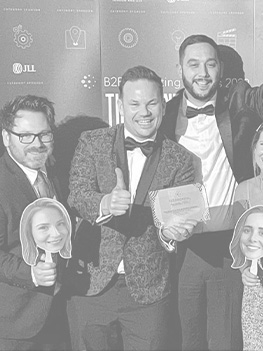March 2024
Creativity in B2B: So much more than a “nice to have”
- Marketing,
- Marketing Effectiveness
AUTHOR

Russ Powell
Founder / MD
If you were asked to describe B2B marketing, we’re pretty sure the first adjectives you’d think of wouldn’t be “creative, exciting, or inventive”...
Hopefully, words like “highly effective, valuable, and strategic” would pop into your head.
But it’s far more likely words like “dull, uninspiring, or boring” would be there at the front of your mind.
Now look. We get it. We understand why this happens.
In the B2B space the focus is on the tech. It’s on products. It’s on “business”. Which is fine (we guess) but when it comes to marketing and injecting a bit of the new, exciting, and bold into proceedings, it just doesn’t happen.
Or if it does, it gets watered down by management committees, brand police and higher-ups who don’t want to rock the boat. And that translates into activity that’s so middle of the road it’d make Coldplay look edgier than a dismantled Rubik’s cube.
Things have to be safe. They have to be brand compliant. They have to be proven (which means copying the competition).
“But we need to be seen as professional,” Angela whispers from the back of the marketing meeting.
Pipe down Ange.
Yes, professional. But you also need to grab the attention of your audience. You need to stand up and stand out. You need to be meaningfully different. And beige just won’t cut it.
So how do you anti-beige? How do you stand up/out? How do you cut through?
THE CASE FOR CREATIVITY
Simple(ish). You lead with creativity.
Your audience might be B2B but you’re still trying to engage people – and you know what people react to really, really well? Creativity.
New ideas. Novel experiences. Different, unseen, brand new things. Which doesn’t sound anything like your last whitepaper, webinar and one-pager triple threat of the mundane.
So, how can you use creativity to engage, to capture attention, and to be meaningfully different to your target audience?
Wouldn’t you know it, we’ve got three top tips for you:
- Get personal with your audience
Before you can get creative with your marketing, you need to have a really deep and clear understanding of who you need to be creative for/to.
Which comes from well-constructed targeting at an individual level. Because remember businesses, sectors, industries, and geographic regions don’t buy anything. It’s the people within those businesses who are making those buying decisions.
And this goes well beyond homogenous groups like “IT Decision Makers” and demographic buckets that lump people together by age, salary, education, or some other nonsensical variable (that will have zero impact or influence on anything).
Instead, you need to get into the nitty gritty of the challenges, problems, and issues that specific groups of individuals in similar roles will face. And then – MOST importantly – you need to get to grips with how they will likely think, feel, and react.
What keeps them up at night? What’s motivating them to get out of bed in the morning? What headache could be removed that would make their life better, easier, or generally more good?
What are the emotional and rational desires they need to meet to feel/know they’re doing a good job and delivering value for their organisation?
With a good grasp of what truly influences the people you’re targeting, you can get a much better idea of what might grab their attention.
- Match needs to solutions (with meaning)
Once you understand your audience’s pain points and drivers, you can start to identify the solutions/services/products you offer that meet those needs.
How does what you do change their lives (for the better)? What’s unique about your products or services? Why should they choose you over the myriad other organisations offering a similar solution?
N.B. If you can’t answer these questions then you really need to go back to the drawing board to define your positioning and value props as a business. If you need a hand with these, just give us a shout.What’s vital here though is that what you do is seen as being meaningfully different.
Being different is easy. You can just be whacky, weird, and odd without breaking a sweat. Sure, you might catch someone’s eye for a moment, but you’ll quickly get passed over as just being whacky, weird, and odd.
The real magic comes from being meaningfully different – which is all about talking to, relating to, and engaging with people in a way that is entirely relevant to them, makes them feel seen, and demonstrates a clear understanding of their world.
(Which all comes from doing the groundwork in point 1, above).
If the way you talk about and promote what you do to your target audience doesn’t convey meaningful difference, you’ll just end up as noise. And that’s not a great place to be for delivering ROI.
So, once you’ve built an understanding of your target audiences and you’ve nailed how to be meaningfully different to them, that’s when the creative sparks can start to fly…
- Find the creative bridge
The final piece of the puzzle is to then link what you know about your audience and what makes you meaningfully different in a creative, attention-grabbing way.
Creativity isn’t reserved for the big brands who have the funds to dish out mind-boggling campaigns. Creative ideas and approaches can be found hiding under many different metaphorical rocks.
Unfortunately, there isn’t a scientific formula for coming up with creative ideas though. If there were we would have patented it, become billionaires, and be writing this blog from our private island in the Caribbean.
However, there are a number of techniques and exercises we use to come up with our award-winning creative campaigns:
- Word Association games. This is especially handy if you’ve got some pre-existing content to work from. Read it through and pick out what feel like the key words/phrases/terms. How else could they be interpreted? What other things do they make you think of? In what other places have you seen words like that used? If you can find new associations, you then uncover some creative threads that can be pulled on to see what develops.
- Mixing and Matching. Take two random things and see how they could be mashed together. For instance, you wouldn’t necessarily put Horror Movies and IT decision maker challenges together but that’s what we did with this award-winning campaign with Proact. Combining existing things in new ways can lead to highly creative ideas coming through.
- Think like a five-year-old. A lot of the time, things just get accepted as the way they are because that’s how we’ve always known them to be. But if you start to question things, challenge the perceived wisdom, and just ask “why?” (as five-year-olds do on a constant basis) you might uncover something entirely new that’s been sat in front of you the whole time.
- Create gaps. Being creative isn’t an exact exercise. It’s very hard to sit down at a desk, give yourself half an hour, and “be creative”. Instead, you need to create “gaps” in which creative ideas can grow. Take breaks, go for a walk, do nothing. Some of our best ideas have come to us when out on a run, washing the car, and even whilst in the shower. Give yourself the creative challenge to answer and then give your brain the time and “gaps” to process it.
It's our belief that creativity will be the driving force behind B2B success for the future.
Playing it safe and doing what you’ve always done isn’t going to get you the results and ROI you want. If you consider the law of diminishing return, it’s likely they’ll just get worse…


